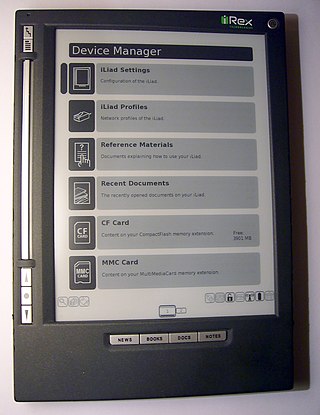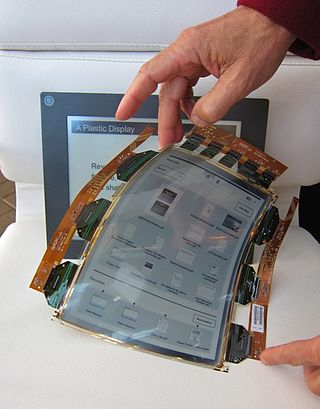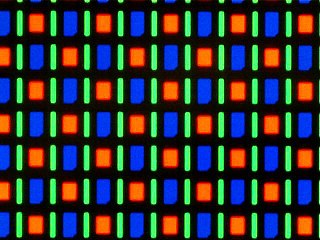Related Research Articles

Electronic paper, also sometimes electronic ink, e-ink or electrophoretic display, are display devices that mimic the appearance of ordinary ink on paper. Unlike conventional flat panel displays that emit light, an electronic paper display reflects ambient light like paper. This may make them more comfortable to read, and provide a wider viewing angle than most light-emitting displays. The contrast ratio in electronic displays available as of 2008 approaches newspaper, and newly (2008) developed displays are slightly better. An ideal e-paper display can be read in direct sunlight without the image appearing to fade.

A liquid-crystal display (LCD) is a flat-panel display or other electronically modulated optical device that uses the light-modulating properties of liquid crystals combined with polarizers. Liquid crystals do not emit light directly but instead use a backlight or reflector to produce images in color or monochrome. LCDs are available to display arbitrary images or fixed images with low information content, which can be displayed or hidden. For instance: preset words, digits, and seven-segment displays, as in a digital clock, are all good examples of devices with these displays. They use the same basic technology, except that arbitrary images are made from a matrix of small pixels, while other displays have larger elements. LCDs can either be normally on (positive) or off (negative), depending on the polarizer arrangement. For example, a character positive LCD with a backlight will have black lettering on a background that is the color of the backlight, and a character negative LCD will have a black background with the letters being of the same color as the backlight. Optical filters are added to white on blue LCDs to give them their characteristic appearance.

An organic light-emitting diode, also known as organic electroluminescentdiode, is a light-emitting diode (LED) in which the emissive electroluminescent layer is a film of organic compound that emits light in response to an electric current. This organic layer is situated between two electrodes; typically, at least one of these electrodes is transparent. OLEDs are used to create digital displays in devices such as television screens, computer monitors, and portable systems such as smartphones and handheld game consoles. A major area of research is the development of white OLED devices for use in solid-state lighting applications.

A flat-panel display (FPD) is an electronic display used to display visual content such as text or images. It is present in consumer, medical, transportation, and industrial equipment.

A display device is an output device for presentation of information in visual or tactile form. When the input information that is supplied has an electrical signal the display is called an electronic display.

A television set or television receiver, more commonly called the television, TV, TV set, telly, tele, or tube, is a device that combines a tuner, display, and loudspeakers, for the purpose of viewing and hearing television broadcasts, or using it as a computer monitor. Introduced in the late 1920s in mechanical form, television sets became a popular consumer product after World War II in electronic form, using cathode ray tube (CRT) technology. The addition of color to broadcast television after 1953 further increased the popularity of television sets in the 1960s, and an outdoor antenna became a common feature of suburban homes. The ubiquitous television set became the display device for the first recorded media in the 1970s, such as, VHS and later DVD. It has been used as a display device since the first generation of and dedicated video game consoles in the 1980s. By the early 2010s, flat-panel television incorporating liquid-crystal display (LCD) technology, especially LED-backlit LCD technology, largely replaced CRT and other display technologies. Modern flat panel TVs are typically capable of high-definition display and can also play content from a USB device. Starting in the late 2010s, most flat panel TVs began to offer 4K and 8K resolutions.

A mobile device is a computer small enough to hold and operate in the hand. Mobile devices typically have a flat LCD or OLED screen, a touchscreen interface, and digital or physical buttons. They may also have a physical keyboard. Many such devices can connect to the Internet and connect with other devices such as car entertainment systems or headsets via Wi-Fi, Bluetooth, cellular networks or near field communication (NFC). Integrated cameras, the ability to place and receive voice and video telephone calls, video games, and Global Positioning System (GPS) capabilities are common. Power is typically provided by a lithium-ion battery. Mobile devices may run mobile operating systems that allow third-party applications to be installed and run.
An output device is any piece of computer hardware equipment which converts information into a human-perceptible form or, historically, into a physical machine-readable form for use with other non-computerized equipment. It can be text, graphics, tactile, audio, or video. Examples include monitors, printers, speakers, headphones, projectors, GPS devices, optical mark readers, and braille readers.
An e-reader, also known as an e-book reader, is a portable electronic device that is designed primarily for the purpose of reading e-books and periodicals. E-readers have a similar form factor to a tablet and usually refers to devices that use electronic paper resulting in better screen readability, especially in bright sunlight, and longer battery life when compared to a tablet. An e-reader's battery will typically last for multiple weeks. In contrast to an e-reader, a tablet has a screen capable of higher refresh rates which make them more suitable for interaction such as playing a video game or watching a video clip.

Bravia is a brand of Sony Visual Products Inc., a wholly owned subsidiary of Sony Corporation, and used for its television products. Its backronym is "Best Resolution Audio Visual Integrated Architecture". All Sony high-definition flat-panel LCD televisions in North America have carried the logo for BRAVIA since 2005. BRAVIA replaces the "LCD WEGA" which Sony used for their LCD TVs until Summer 2005. In 2014, in part of Sony President & CEO Kasuo Hirai's plans to turn Sony around, BRAVIA was made into an subsidiary rather than just a brand of products.

The iLiad was an electronic handheld device, or e-Reader, which could be used for document reading and editing. Like the Barnes and Noble nook, Sony Reader or Amazon Kindle, the iLiad made use of an electronic paper display. In 2010, sales of the iLiad ended when its parent company, iRex Technologies, filed for bankruptcy.

A flexible display or rollable display is an electronic visual display which is flexible in nature, as opposed to the traditional flat screen displays used in most electronic devices. In recent years there has been a growing interest from numerous consumer electronics manufacturers to apply this display technology in e-readers, mobile phones and other consumer electronics. Such screens can be rolled up like a scroll without the image or text being distorted. Technologies involved in building a rollable display include electronic ink, Gyricon, Organic LCD, and OLED.

An e-reader, also called an e-book reader or e-book device, is a mobile electronic device that is designed primarily for the purpose of reading digital e-books and periodicals.

AMOLED is a type of OLED display device technology. OLED describes a specific type of thin-film-display technology in which organic compounds form the electroluminescent material, and active matrix refers to the technology behind the addressing of pixels.
A digital newspaper is a digital version of a printed newspaper. Newspapers can be digitally published online or as a digital copy on a digital device, such as a mobile phone or an E Ink reader.
Electrically operated display devices have developed from electromechanical systems for display of text, up to all-electronic devices capable of full-motion 3D color graphic displays. Electromagnetic devices, using a solenoid coil to control a visible flag or flap, were the earliest type, and were used for text displays such as stock market prices and arrival/departure display times. The cathode ray tube was the workhorse of text and video display technology for several decades until being displaced by plasma, liquid crystal (LCD), and solid-state devices such as thin-film transistors (TFTs), LEDs and OLEDs. With the advent of metal-oxide-semiconductor field-effect transistors (MOSFETs), integrated circuit (IC) chips, microprocessors, and microelectronic devices, many more individual picture elements ("pixels") could be incorporated into one display device, allowing graphic displays and video.

A quantum dot display is a display device that uses quantum dots (QD), semiconductor nanocrystals which can produce pure monochromatic red, green, and blue light.
Universal Display Corporation is a developer and manufacturer of organic light emitting diodes (OLED) technologies and materials as well as provider of services to the display and lighting industries. It is also an OLED research company. Founded in 1994, the company currently owns or has exclusive, co-exclusive or sole license rights with respect to more than 3,000 issued and pending patents worldwide for the commercialization of phosphorescent based OLEDs and also flexible, transparent and stacked OLEDs - for both display and lighting applications. Its phosphorescent OLED technologies and materials are licensed and supplied to companies such as Samsung, LG, AU Optronics CMEL, Pioneer, Panasonic Idemitsu OLED lighting and Konica Minolta.
A see-through display or transparent display is an electronic display that allows the user to see what is shown on the screen while still being able to see through it. The main applications of this type of display are in head-up displays, augmented reality systems, digital signage, and general large-scale spatial light modulation. They should be distinguished from image-combination systems which achieve visually similar effects by optically combining multiple images in the field of view. Transparent displays embed the active matrix of the display in the field of view, which generally allows them to be more compact than combination-based systems.
References
- ↑ Vourlias, Christopher. "NYT searchable archive". The New York Times. Retrieved 2009-02-23.
- ↑ "Tech's hope in 2009 - or curse?". Fortune Magazine, December 24, 2008, Jon Fortt. December 24, 2008. Retrieved May 1, 2010.
- ↑ blogs.wsj.com
- ↑ www.engadget.com
- ↑ Sanburn, Josh (2011-02-01). "A Brief History of Digital News". Time. ISSN 0040-781X . Retrieved 2020-11-25.
- ↑ www.gartner.com
- ↑ www.crunchgear.com
- ↑ www.nytimes.com
- ↑ www.nytimes.com
- ↑ www.iht.com
- ↑ news.bbc.co.uk
- ↑ Richards, Bill (November 30, 2007). "How an electronic newspaper could become profitable". Crosscut . Retrieved August 13, 2011.
- ↑ www.economist.com
- ↑ www.newsweek.com
- ↑ www.amazon.com
- ↑ amazon.com
- ↑ www.amazon.com
- ↑ www.telegraph.co.uk
- ↑ "openinkpot.org". Archived from the original on 2009-02-06. Retrieved 2009-02-18.
- ↑ "www.readius.com". Archived from the original on 2009-02-12. Retrieved 2009-02-18.
- ↑ "www.plasticlogic.com". Archived from the original on 2009-02-21. Retrieved 2009-02-18.
- ↑ "www.plasticlogic.com". Archived from the original on 2009-02-12. Retrieved 2009-02-18.
- ↑ "Plastic Logic". Quereader.com. Retrieved 2012-02-13.
- ↑ "www.readius.com". Archived from the original on 2019-01-10. Retrieved 2009-02-18.
- ↑ www.engadget.com
- ↑ www.onlinenewspapers.com
- ↑ www.ipl.org
- ↑ news.google.com
- ↑ icon.crl.edu
- ↑ www.pressdisplay.com